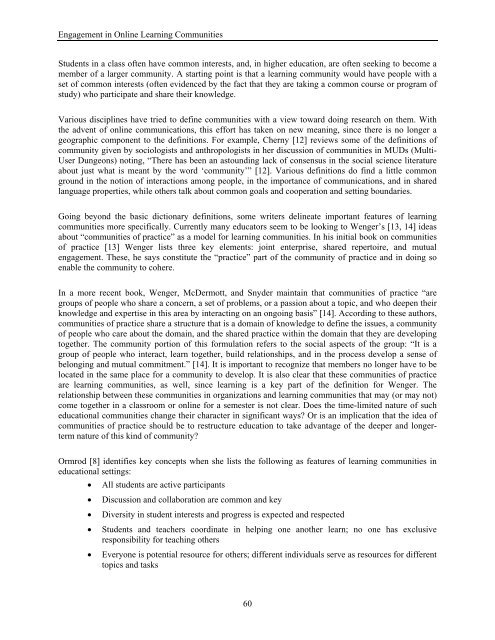Elements of Quality Online Education cation
Elements of Quality Online Education cation
Elements of Quality Online Education cation
You also want an ePaper? Increase the reach of your titles
YUMPU automatically turns print PDFs into web optimized ePapers that Google loves.
Engagement in <strong>Online</strong> Learning CommunitiesStudents in a class <strong>of</strong>ten have common interests, and, in higher edu<strong>cation</strong>, are <strong>of</strong>ten seeking to become amember <strong>of</strong> a larger community. A starting point is that a learning community would have people with aset <strong>of</strong> common interests (<strong>of</strong>ten evidenced by the fact that they are taking a common course or program <strong>of</strong>study) who participate and share their knowledge.Various disciplines have tried to define communities with a view toward doing research on them. Withthe advent <strong>of</strong> online communi<strong>cation</strong>s, this effort has taken on new meaning, since there is no longer ageographic component to the definitions. For example, Cherny [12] reviews some <strong>of</strong> the definitions <strong>of</strong>community given by sociologists and anthropologists in her discussion <strong>of</strong> communities in MUDs (Multi-User Dungeons) noting, “There has been an astounding lack <strong>of</strong> consensus in the social science literatureabout just what is meant by the word ‘community’” [12]. Various definitions do find a little commonground in the notion <strong>of</strong> interactions among people, in the importance <strong>of</strong> communi<strong>cation</strong>s, and in sharedlanguage properties, while others talk about common goals and cooperation and setting boundaries.Going beyond the basic dictionary definitions, some writers delineate important features <strong>of</strong> learningcommunities more specifically. Currently many educators seem to be looking to Wenger’s [13, 14] ideasabout “communities <strong>of</strong> practice” as a model for learning communities. In his initial book on communities<strong>of</strong> practice [13] Wenger lists three key elements: joint enterprise, shared repertoire, and mutualengagement. These, he says constitute the “practice” part <strong>of</strong> the community <strong>of</strong> practice and in doing soenable the community to cohere.In a more recent book, Wenger, McDermott, and Snyder maintain that communities <strong>of</strong> practice “aregroups <strong>of</strong> people who share a concern, a set <strong>of</strong> problems, or a passion about a topic, and who deepen theirknowledge and expertise in this area by interacting on an ongoing basis” [14]. According to these authors,communities <strong>of</strong> practice share a structure that is a domain <strong>of</strong> knowledge to define the issues, a community<strong>of</strong> people who care about the domain, and the shared practice within the domain that they are developingtogether. The community portion <strong>of</strong> this formulation refers to the social aspects <strong>of</strong> the group: “It is agroup <strong>of</strong> people who interact, learn together, build relationships, and in the process develop a sense <strong>of</strong>belonging and mutual commitment.” [14]. It is important to recognize that members no longer have to belocated in the same place for a community to develop. It is also clear that these communities <strong>of</strong> practiceare learning communities, as well, since learning is a key part <strong>of</strong> the definition for Wenger. Therelationship between these communities in organizations and learning communities that may (or may not)come together in a classroom or online for a semester is not clear. Does the time-limited nature <strong>of</strong> suchedu<strong>cation</strong>al communities change their character in significant ways? Or is an impli<strong>cation</strong> that the idea <strong>of</strong>communities <strong>of</strong> practice should be to restructure edu<strong>cation</strong> to take advantage <strong>of</strong> the deeper and longertermnature <strong>of</strong> this kind <strong>of</strong> community?Ormrod [8] identifies key concepts when she lists the following as features <strong>of</strong> learning communities inedu<strong>cation</strong>al settings:• All students are active participants• Discussion and collaboration are common and key• Diversity in student interests and progress is expected and respected• Students and teachers coordinate in helping one another learn; no one has exclusiveresponsibility for teaching others• Everyone is potential resource for others; different individuals serve as resources for differenttopics and tasks60
















